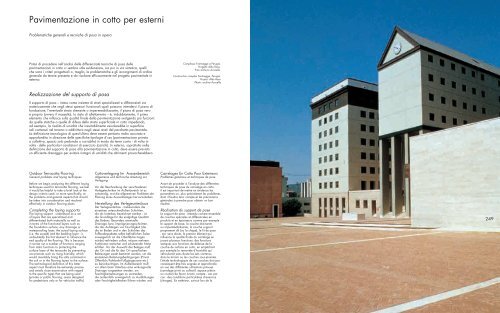by Stone & Sannini - EKA Group
by Stone & Sannini - EKA Group
by Stone & Sannini - EKA Group
You also want an ePaper? Increase the reach of your titles
YUMPU automatically turns print PDFs into web optimized ePapers that Google loves.
Pavimentazione in cotto per esterni<br />
Problematiche generali e tecniche di posa in opera<br />
Prima di procedere nell’analisi delle differenziate tecniche di posa delle<br />
pavimentazioni in cotto ci sembra utile evidenziare, sia pur in via sintetica, quelli<br />
che sono i criteri progettuali o, meglio, le problematiche e gli accorgimenti di ordine<br />
generale da tenere presente e da risolvere efficacemente nel progetto pavimentale in<br />
esterno.<br />
Realizzazione del supporto di posa<br />
Il supporto di posa -- inteso come insieme di strati specializzati e differenziati sia<br />
matericamente che negli stessi spessori funzionali quali possono intendersi il piano di<br />
fondazione, l’eventuale strato drenante o impermeabilizzante, il piano di posa vero<br />
e proprio (ovvero il massetto), lo stato di allettamento -- è, indubbiamente, il primo<br />
elemento che influisce sulla qualità finale della pavimentazione svolgendo più funzioni:<br />
da quelle statiche a quelle di difesa dello strato superficiale in cotto impedendo,<br />
ad esempio, la risalita di umidità che inevitabilmente veicolerebbe in superficie<br />
sali contenuti nel terreno o addirittura negli stessi strati del pacchetto pavimentale.<br />
La definizione tecnologica di quest’ultimo deve essere pertanto molto accurata e<br />
approfondita in direzione delle specifiche tipologie d’uso (pavimentazione privata<br />
o collettiva, spazio solo pedonale o carrabile) in modo da tener conto - di volta in<br />
volta - delle particolari condizioni di esercizio (carichi). In esterno, soprattutto nella<br />
definizione del supporto di posa alla pavimentazione in cotto, deve essere previsto<br />
un efficiente drenaggio per evitare ristagni di umidità che altrimenti provocherebbero<br />
Outdoor Terracotta Flooring<br />
General problems and laying techniques<br />
Before we begin analyzing the different laying<br />
techniques used for terracotta flooring, we feel<br />
it would be helpful to take a brief look at the<br />
design criteria used, or more specifically, at<br />
the problems and general aspects that should<br />
be taken into consideration and resolved<br />
effectively in outdoor flooring plans.<br />
Completing the laying supporta<br />
The laying support - understood as a set<br />
of layers that are specialized and<br />
differentiated both materially as well as<br />
in terms of the functional layers such as<br />
the foundation surface, any drainage or<br />
waterproofing layer, the actual laying surface<br />
(i.e. the screed) and the bedding layer - is<br />
undoubtedly the first element to influence the<br />
end quality of the flooring. This is because<br />
it carries out a number of functions ranging<br />
from static functions to protecting the<br />
surface layer of the terracotta <strong>by</strong> preventing<br />
occurrences such as rising humidity, which<br />
would inevitably bring the salts contained in<br />
the soil or in the flooring layers to the surface.<br />
The technological definition of this latter<br />
aspect must therefore be extremely precise<br />
and entails close examination with regard<br />
to the specific types that are being used<br />
(private or public flooring, areas designed<br />
for pedestrians only or for vehicular traffic)<br />
Cottoverlegung Im Aussenbereich<br />
Allgemeine und technische Anleitung zur<br />
Verlegung<br />
Vor der Beschreibung der verschiedenen<br />
Verlegetechniken im Außenbereich ist es<br />
notwendig, erst die allgemeinen Probleme der<br />
Planung eines Aussenbelages hervorzuheben.<br />
Herstellung des Verlegeunterbaus<br />
Der Verlegeunterbau - insbesonders die<br />
einzelnen unterschiedlichen Schichten,<br />
die als Unterbau bezeichnet werden - ist<br />
die Grundlage für die endgültige Qualität<br />
des Bodens. Besonders eventuelle<br />
Drainage- bzw. Imprägnierungsschichten,<br />
die das Aufsteigen von Feuchtigkeit (die<br />
die im Boden und in den Schichten des<br />
Fußbodenpaketes selbst befindlichen Salze<br />
unweigerlich an die Oberfläche tragen<br />
würde) verhindern sollen, müssen mehrere<br />
Funktionen statischer und schützender Natur<br />
erfüllen. Vor der Auswahl des Belages muß<br />
der Ort und die für den Ort spezifischen<br />
Belastungen exakt bestimmt werden, um die<br />
einzelenen Belastungsbedingungen (Privat-<br />
Öffentlich/Fahrbahn-Fußgängerzone etc.)<br />
zu berücksichtigen. Im Außenbereich muß<br />
vor allem beim Unterbau eine wirkungsvolle<br />
Drainage vorgesehen werden, um<br />
Feuchtigkeitsstauungen zu vermeiden,<br />
die andernfalls unweigerlich zu Ausblühungen<br />
oder Feuchtigkeitsflecken führen würden und<br />
Complesso Fontivegge a Perugia.<br />
Progetto Aldo Rossi.<br />
Foto archivio Acocella.<br />
Construction complex Fontivegge, Perugia.<br />
Project: Aldo Rossi<br />
Photo: archive Acocella<br />
Carrelages En Cotto Pour Exterieurs<br />
Problèmes généraux et techniques de pose<br />
Avant de procéder à l’analyse des différentes<br />
techniques de pose du carrelage en cotto,<br />
il est important de mettre en évidence les<br />
paramètres ou, plus précisément les problèmes<br />
dont il faudra tenir compte et les précautions<br />
générales à prendre pour obtenir un bon<br />
résultat.<br />
Réalisation du support de pose<br />
Le support de pose - entendu comme ensemble<br />
de couches spéciales et différenciées en<br />
produits et en épaisseurs comme par exemple<br />
le support de base, la couche drainante<br />
ou imperméabilisante, la couche support<br />
proprement dit (ou la chape), le lit de pose<br />
- est, sans doute, le premier élément qui<br />
influence la qualité finale du carrelage en<br />
jouant plusieurs fonctions: des fonctions<br />
statiques aux fonctions de défense de la<br />
couche de surface en cotto, en empêchant<br />
par exemple la remontée d’humidité qui<br />
véhiculerait sans doute les sels contenus<br />
dans le terrain ou les couches sous-jacentes.<br />
L’étude technologique de ces couches doit par<br />
conséquent être très soignée et approfondie<br />
en vue des différentes utilisations prévues<br />
(carrelage privé ou collectif, espace piéton<br />
ou routier) de façon à tenir compte - cas par<br />
cas - des conditions particulières d’exercice<br />
(charges). En extérieur, surtout lors de la<br />
249





